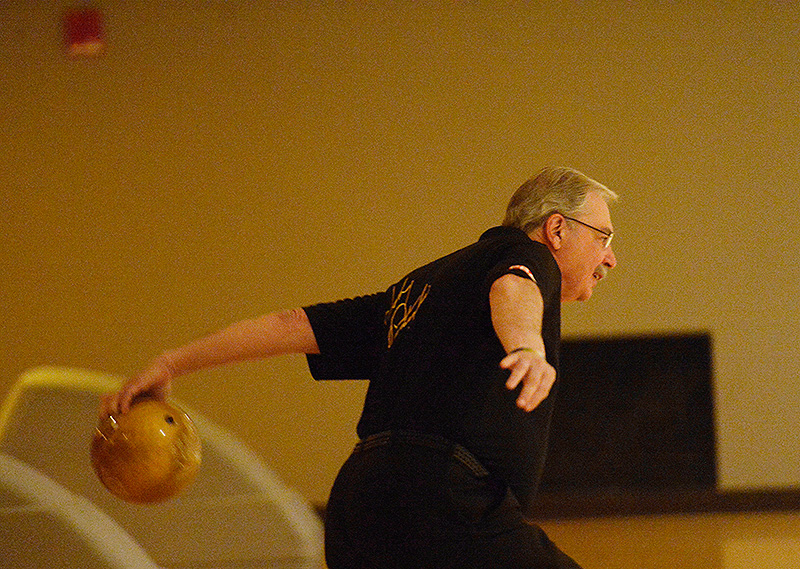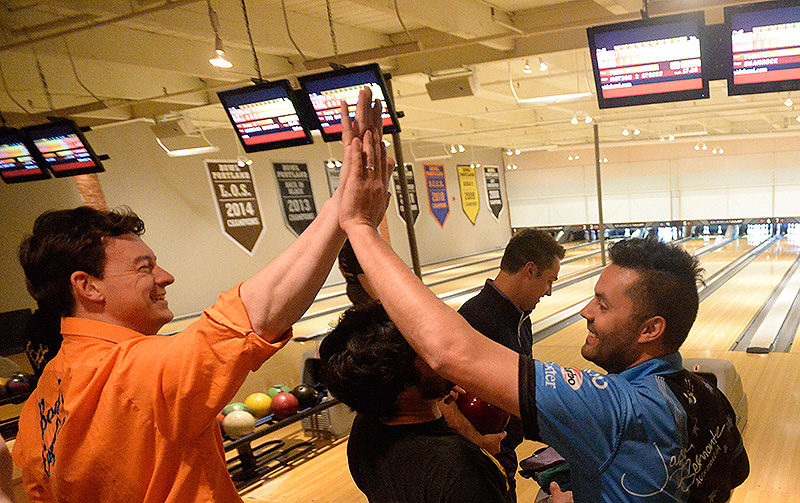Jason Belmonte is a world-famous bowler.
Yes, they do exist.
The 31-year-old Australian is at the apex of his sport, jetting around the world for competitions six or seven months each year. Inevitably, he is approached by fans at airports or on the streets.
“They’re always pretty polite. It’s cool. It’s daunting, though,” Belmonte said. “When you have two or three people who tap you on your shoulder out of nowhere at a baseball game and say, ‘Hey, we want your autograph,’ and you’re like, ‘You know there are baseball players here, right?'”
If you don’t know Belmonte, here’s your chance. He is among 40 of the world’s best bowlers who have come to Portland to compete in two Professional Bowlers Association events at Bayside Bowl. The events run through Tuesday.
If you think of bowling as merely a working-class recreation, where the middle-aged don comical shoes and mingle among the clinking of beer bottles, you’ve got the wrong sport.
There is glamour on the PBA Tour, which is stopping in Maine for the first time. Belmonte’s exotic accent and mesmerizing two-handed delivery are made for TV, and this weekend’s team competition – the Elias Cup finals – will be aired on ESPN over four Sundays, starting this Sunday from 5 to 7 p.m.
The travel is exhaustive and the stakes are high on the PBA Tour. Many of the bowlers here flew in from Munich, Germany, where they competed last weekend. The purse for the Elias Cup is $250,000, with the winning team splitting $50,000. The prize money for Monday and Tuesday’s Xtra Frame Maine Shootout, an individual competition, is $62,000, with the winner getting $10,000.
“The best bowlers every week turn up to the PBA,” said Belmonte, who has been the class of the tour for the past three seasons. “Here, one error and you feel it. You feel the pressure that they put on you.
“You’re bowling for your living, for your families. So it’s hard to be friends with everyone. I tried. Didn’t work. So you’ve kind of got to turn that friendship and personality side off when you’re in the lanes. You’ve got a job. Hopefully, at the end of the tournament I can shake a guy’s hand and buy him a beer.”
Belmonte can afford the beers. He led the tour with earnings of $163,778 last year, money that can be supplemented by sponsorships and competing in non-PBA tournaments.
PAST PRIME-TIME PEAK
But the big paydays are harder to come by since bowling’s heyday. From 1961 to 1997, the Pro Bowlers Tour was a Saturday afternoon staple on ABC, routinely drawing more viewers than college football telecasts. At its peak, 20 million Americans would tune in, making household names out of guys like Johnny Petraglia and Pete Weber, both of whom are in Portland this week.
By 1997, with cable TV stations offering an array of sports options to younger and younger viewers, ABC pulled the plug. Research showed that 67 percent of those tuning in to bowling then were age 50 and older, not an attractive demographic to advertisers.
“When I first started, we had 36 TV shows and all were live,” said Weber, 52, who has earned $3.8 million in his 35 years on tour. “Now we might have 10 TV shows and maybe three of them are live. I wish we could get ABC back or any major network that’s not on cable.”
Nielsen ratings for the Jan. 4 telecast of the PBA Scorpion Championship on ESPN averaged 923,000 viewers. Ratings rose 18 percent from 2013 to 2014, but still it’s obvious that televised bowling will never have the appeal it did when Petraglia hit the scene as an 18-year-old in 1965. He won his first tournament the next year in Fort Smith, Arkansas, took a year off to serve in the Vietnam War, and returned to become good enough to be elected to the PBA Hall of Fame in 1982. He once earned a $100,000 bonus for bowling a 300 game on live TV.
“Those first 10 years were just so special, seeing different cities and different countries and bowling. I loved the road,” Petraglia said.
He found time to get married, raise two children at his home in New Jersey, and has worked for the Brunswick bowling company for the past 44 years, giving him a steady paycheck to supplement the $1.25 million he’s won on the tour. This weekend, he is serving as the manager of one of the eight teams of five bowlers competing in the Elias Cup.
Petraglia still bowls in some senior tour events, works trade shows and conducts clinics (including one in Hallowell this past Thursday). But he’s planning to scale back his travel considerably when he turns 70 in two years. It’s been quite a ride for the kid from Brooklyn, New York.
“I don’t know what else I would have done,” he said. “I would have ended up like most of my friends in Brooklyn. They ended up city workers, cops, crooks. My family never owned a car and most of my friends didn’t, either. We just lived in a three-room apartment. I was on tour early enough that I didn’t have to think about (a different job).”
WEBER ROLLS 202 AT AGE 6
Weber started on the tour at age 17, but he grew up with bowling. His father, Dick, was a titan of the sport, one of the founders of the PBA. Pete recalls rolling a 202 at age 6. He used to hustle his dad’s professional peers in head-to-head matches. His prize? A free soda.
“I got 10 in one day,” he said, shaking his head at the memory. “No kid needs that much soda.”
Weber was blessed with a popular name, but decided to take things in a different direction than his beloved father. He became the sport’s villain, spewing profanity when he made a poor shot, flashing his obscene “crotch chop” motion when he won.
“To those people that don’t like me, fine, you don’t like me. But I know you’re going to watch the next TV show I’m on just to see what I do, so obviously they do like me enough to watch,” Weber said.
He was more of a loner on the road, except for joining in the ubiquitous golf games that all bowlers seem to revel in.
He was good enough to win 10 major tournaments, and his five U.S. Open victories in bowling allowed him to surpass even his father. When Dick Weber died in 2005, Pete decided to tone down some of his antics.
“I’m still a rebel, but I’m a lot more nicer on the lanes than I ever was before. And I think the people are liking that,” he said. “And I have to live up to what Dick Weber did for bowling. Not full time, but I have to live up sometime.”
Weber has seen his sport wane in popularity and start to crawl back recently. He doesn’t expect it to ever get back to where it was, and notes with regret that the $100,000 prize that used to come with winning a major tournament is now half of that.
“If you don’t finish in the top 10 now, you’re really not making any money, when you consider the cost of travel,” he said.
But he has no intention of hanging it up anytime soon. For one thing, he needs to keep the younger generation in place.
“I still love bowling against these kids who think they’re all that and they’re really not because they don’t scare me one bit,” Weber said, an obvious reference to Belmonte. “I love to bowl the young kids on TV and then whoop ’em.”
GETTING STARTED AT WICHITA STATE
In between those two generations are bowlers like Chris Barnes. At age 45, he is old enough to remember when bowling was must-see TV. But he didn’t join the tour until 1998, after starring in the sport at Wichita State University and as a representative of the U.S. national team.
Still, he has been good enough to earn $2.3 million on the tour, and that doesn’t count the $200,000 prizes he took in 2005 and 2006 for winning the first two Roll to Riches made-for-TV events.
Barnes used to spend 250 days a year on the road. These days, he’s more settled, living in Dallas with wife, Lynda (also a pro bowler), and their 12-year-old twin sons.
“We’ve had to adapt to the times,” he said. “I really had to cut back so I could be more of a dad.
“The tour is not much different than high school or college. You have groups that like each other. You have groups that don’t. You have young guys that are out having a great time and you have guys that are back in the room playing cards. I started out as a younger guy enjoying the tour lifestyle. I’ve transitioned into probably a less exciting guy overall, but enjoying the ride a lot more.”
FAMILY LIFE CALLS
Even Belmonte, whose career is still gathering steam, feels the tug of family. He has a wife, a 5-year-old daughter and a son who turns 3 next month. All are waiting for him when he returns to his small hometown of Orange, New South Wales, Australia, where his parents own a bowling center and got him started in the sport at 18 months old.
At 16, he flew to Malaysia and won the then-unthinkable sum of $16,000 for rolling a perfect game with his unorthodox style. That’s when he knew he could make a living at his sport.
He spent time on the Asian circuit, lived for a year in France while competing on the European tour and made the leap to the big time in 2009. That’s the PBA and the American market.
Belmonte has dominated ever since, compiling a PBA single-season record by averaging 228.81 in 2012-13.
But the travel is wearisome for someone who lives in far-flung Australia. With connecting flights and layovers, he sometimes spends 24 hours or more in transit to get to a tournament. He exists in a perpetual state of jet lag, although he tries tricks like arriving in cities early in the morning after sleeping on the plane so he can just stay awake the first day and try to settle into a “normal” pattern.
Mostly, though, he misses home and yearns for his family time.
“I’m trying to win as much as I can and as fast as I can so I don’t have to miss too much back home,” Belmonte said. “I’m not a journeyman. I have a family back home. So I kind of want to fast-track a lot of my things and that’s why I work as hard as I can. I don’t want to reach the milestones and tick the things on my list in 20 years. I want to do them in five.”
Bowling has allowed Belmonte to travel to more than 40 countries, and to be recognized in most.
In that sense, he is just like Petraglia, 37 years his senior.
“It was a great life,” Petraglia said. “And I still get stopped all the time at restaurants, whatever, by people who remember me. I got to see the world, all because of bowling. I probably would have never been to all those places otherwise.”
Send questions/comments to the editors.









Success. Please wait for the page to reload. If the page does not reload within 5 seconds, please refresh the page.
Enter your email and password to access comments.
Hi, to comment on stories you must . This profile is in addition to your subscription and website login.
Already have a commenting profile? .
Invalid username/password.
Please check your email to confirm and complete your registration.
Only subscribers are eligible to post comments. Please subscribe or login first for digital access. Here’s why.
Use the form below to reset your password. When you've submitted your account email, we will send an email with a reset code.